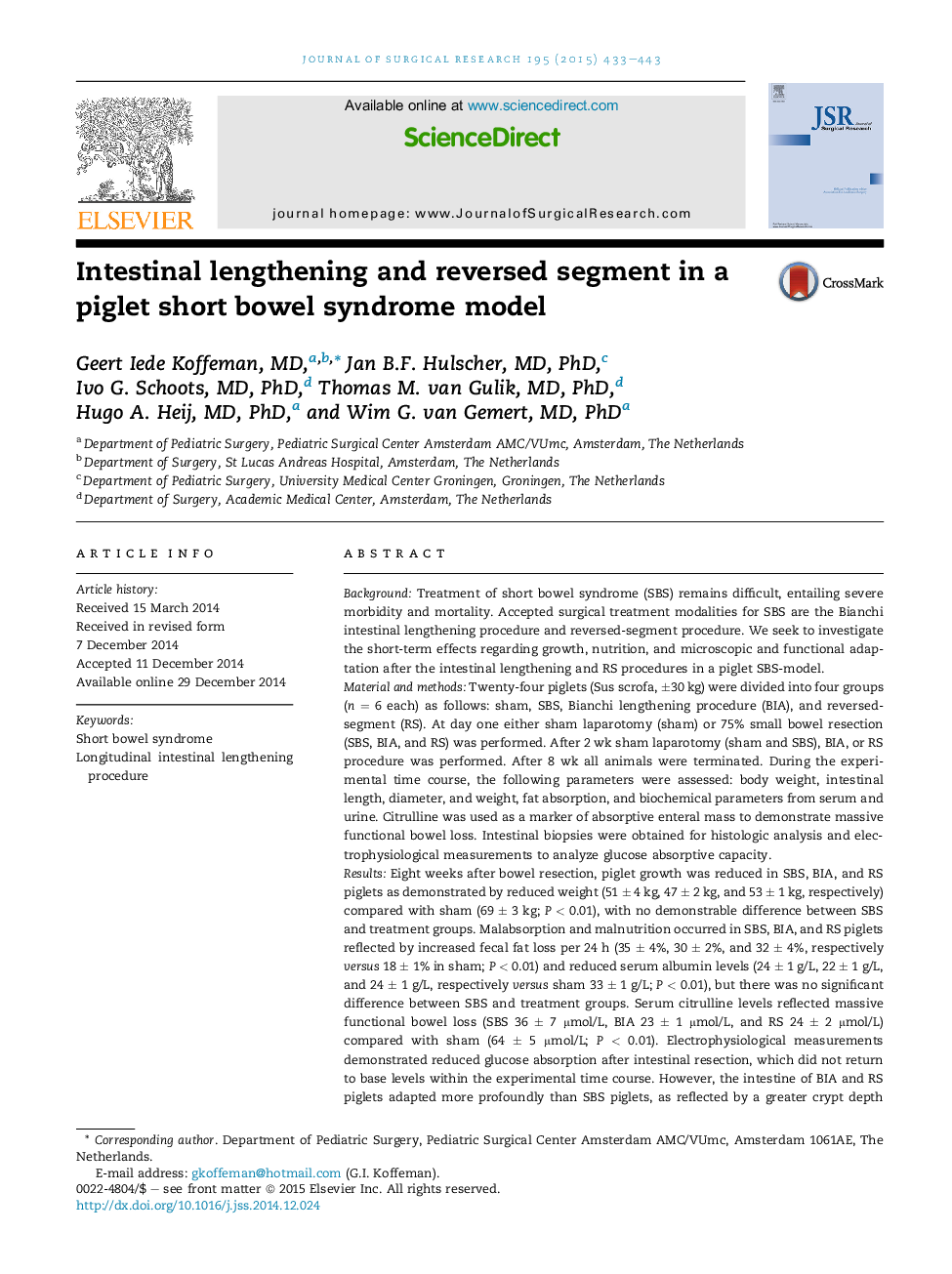| کد مقاله | کد نشریه | سال انتشار | مقاله انگلیسی | نسخه تمام متن |
|---|---|---|---|---|
| 4299674 | 1288398 | 2015 | 11 صفحه PDF | دانلود رایگان |
BackgroundTreatment of short bowel syndrome (SBS) remains difficult, entailing severe morbidity and mortality. Accepted surgical treatment modalities for SBS are the Bianchi intestinal lengthening procedure and reversed-segment procedure. We seek to investigate the short-term effects regarding growth, nutrition, and microscopic and functional adaptation after the intestinal lengthening and RS procedures in a piglet SBS-model.Material and methodsTwenty-four piglets (Sus scrofa, ±30 kg) were divided into four groups (n = 6 each) as follows: sham, SBS, Bianchi lengthening procedure (BIA), and reversed-segment (RS). At day one either sham laparotomy (sham) or 75% small bowel resection (SBS, BIA, and RS) was performed. After 2 wk sham laparotomy (sham and SBS), BIA, or RS procedure was performed. After 8 wk all animals were terminated. During the experimental time course, the following parameters were assessed: body weight, intestinal length, diameter, and weight, fat absorption, and biochemical parameters from serum and urine. Citrulline was used as a marker of absorptive enteral mass to demonstrate massive functional bowel loss. Intestinal biopsies were obtained for histologic analysis and electrophysiological measurements to analyze glucose absorptive capacity.ResultsEight weeks after bowel resection, piglet growth was reduced in SBS, BIA, and RS piglets as demonstrated by reduced weight (51 ± 4 kg, 47 ± 2 kg, and 53 ± 1 kg, respectively) compared with sham (69 ± 3 kg; P < 0.01), with no demonstrable difference between SBS and treatment groups. Malabsorption and malnutrition occurred in SBS, BIA, and RS piglets reflected by increased fecal fat loss per 24 h (35 ± 4%, 30 ± 2%, and 32 ± 4%, respectively versus 18 ± 1% in sham; P < 0.01) and reduced serum albumin levels (24 ± 1 g/L, 22 ± 1 g/L, and 24 ± 1 g/L, respectively versus sham 33 ± 1 g/L; P < 0.01), but there was no significant difference between SBS and treatment groups. Serum citrulline levels reflected massive functional bowel loss (SBS 36 ± 7 μmol/L, BIA 23 ± 1 μmol/L, and RS 24 ± 2 μmol/L) compared with sham (64 ± 5 μmol/L; P < 0.01). Electrophysiological measurements demonstrated reduced glucose absorption after intestinal resection, which did not return to base levels within the experimental time course. However, the intestine of BIA and RS piglets adapted more profoundly than SBS piglets, as reflected by a greater crypt depth (490 ± 25 μm and 492 ± 21 μm versus 388 ± 20 μm; P < 0.01); and BIA piglets showed greater villus length (884 ± 58 μm) than RS or SBS piglets (715 ± 30 μm and 737 ± 64 μm, respectively; P < 0.01) after 8 wk.ConclusionsDespite increased histologic intestinal adaptation, neither intestinal lengthening nor RS procedure demonstrated significantly improved absorption, nutrition, or weight gain for the treatment of SBS during the study period. Reduced glucose uptake on electrophysiology measurements and persistent low levels of citrulline may indicate reduced small bowel enterocyte functioning during the initial phase of intestinal adaptation.
Journal: Journal of Surgical Research - Volume 195, Issue 2, 15 May 2015, Pages 433–443
